Ukraine Road Trip: From Kiev to Crimea, The Heart And Soul Of A Nation On The Brink Of War
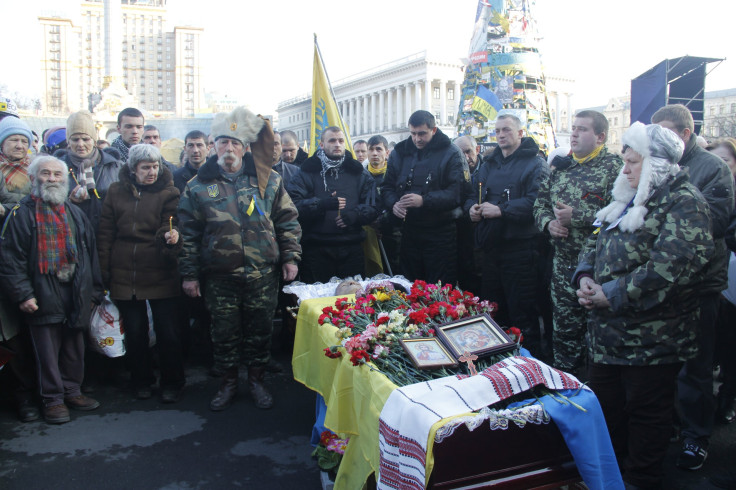
KIEV — This is a city of late awakenings, where Lenin’s statue was only recently toppled, more than two decades after the fall of the Soviet Union, and where shops rarely open before 10 a.m.
On Red Army Street – a name that itself indicates a kind of historical lassitude, Viktoria Konyome, manager of the international fashion house Escada’s local branch, says that despite the remarkable vigor of the Maidan uprising, life – and for her, business -- is slower than ever.
“People are saving money for bread,” she says, her anxious eyes belying the calm of her voice.
Konyome hates to entertain the idea of war. “It would be brothers and sisters killing brothers and sisters -- how can we?” she wonders aloud, looking out the store’s glass door at the waking city. “Ukrainians and Russians have been mingling for centuries. I don’t even know how much in me is Russian and how much Ukrainian.”
And so the question arises: Will the people of Ukraine arise and go forth into the fearful unknown, or wait to see what happens next?
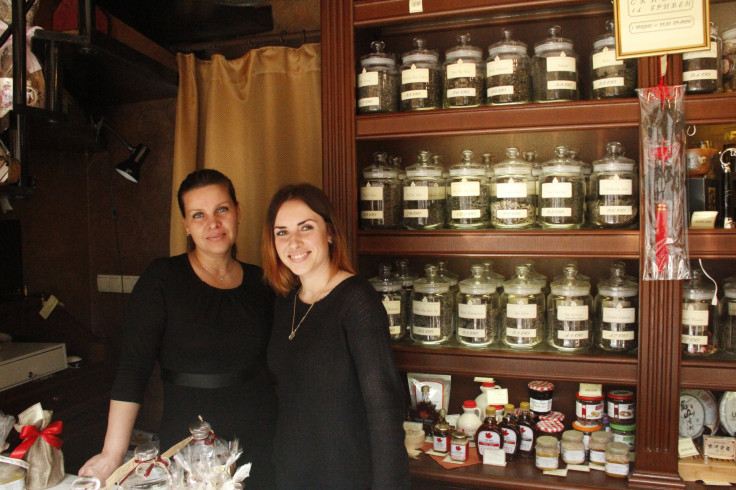
At the nearby upscale tea and coffee store Untsya, Tatyana Sypkyna’s smile also seems to mask her unease. When Sypkyna says she’s Russian, it’s almost as if she is confessing having done something wrong. She refuses to believe the worst, the seeming inevitability of war with Russia, in the way that quietly faithful people refuse to accept a discouraging prognosis for a loved one.
Immersed in the sweet aromas of Far East teas and of coffees from the tropics in the cozy shop, Tatyana and her colleague Polina Hervasyuk face the sunny day outside with luminous eyes and bright smiles. War and all other evils seem light-years away.
Business has slowed down at Untsya, too. Not only are the shop’s customers spending less; there are fewer of them. The problem is the location, only a few blocks from Maidan Square, an area frequented only by diehards now.
At the square, surrounded by barricades of tires, you step into a different historical dimension. Men and a few women, most wearing military fatigues, occupy a tent city under blue and yellow Ukrainian flags. Scattered among them are people dressed in the black of nationalist groups, their banners inscribed with the names of their own cities and regions, and here and there, other types of flags, including that of the European Union -- blue with a ring of gold stars.
These are the Maidan revolutionaries who toppled President Viktor Yanukovich and triggered the chain reaction that has now become the prelude to war with Russia. Smoke rises from the improvised courtyards between the tents, where men sit around bonfires smoking and drinking tea. Often their clothes are old, or old-fashioned: Cossacks wear tall Astrakhan hats; others, repurposed army caps or hats with insignia ranging from the Maidan Revolution self-defense brigades to the Ukrainian Insurgent Army of the 1940s and 1950s.
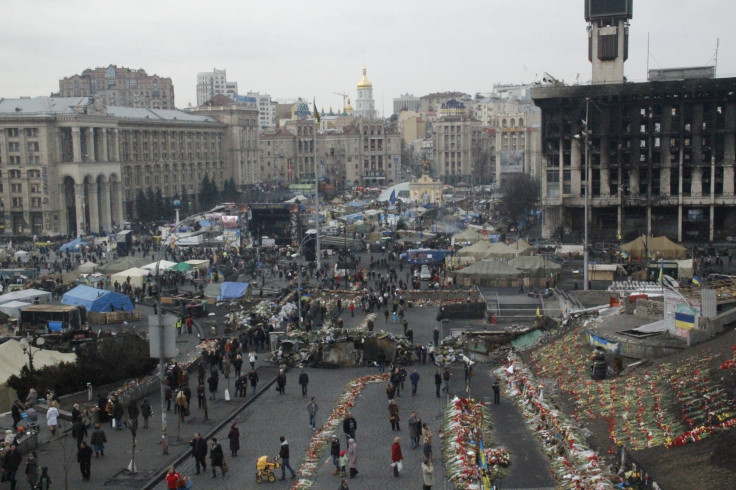
Amid the restless languor of the camps, rhythmic footsteps announce the approach of a column of men. A young voice barks, “Give way!” and a dozen men arrive, marching in two files, dressed in black clothes; many wear ski masks; a few wear black motorcycle helmets with the Plexiglas visors down. Some carry clubs. They look like a small ad hoc march of doom.
The column marches past the podium from which revolutionaries, priests and other speakers address the Maidaners or singers perform for the public, and the fountain with its monument to the legendary founders of Kiev – brothers Kie, Schek, Horiv and their sister Libed, the men in armor and capes, one holding a bow and a hunter’s horn, the sister with her arms outstretched, now holding Ukrainian flags.
Inside a nearby tent, an elderly man in full Cossack uniform, Yusyp Mihal, loudly repudiates his Cossack brethren across the border for doing the Russian government’s bidding in Crimea. “They have forgotten where they come from, they are traitors to their own people,” he says angrily. A bear of a man with a long handlebar moustache enters the tent and hugs Mihal, who doesn’t get up. A procession of other men in Cossack uniforms come and pay their respects to Mihal, a Cossack leader and the author of a little patriotic pamphlet, “God-blessed, Immortal Ukraine,” which he hands out to visitors.
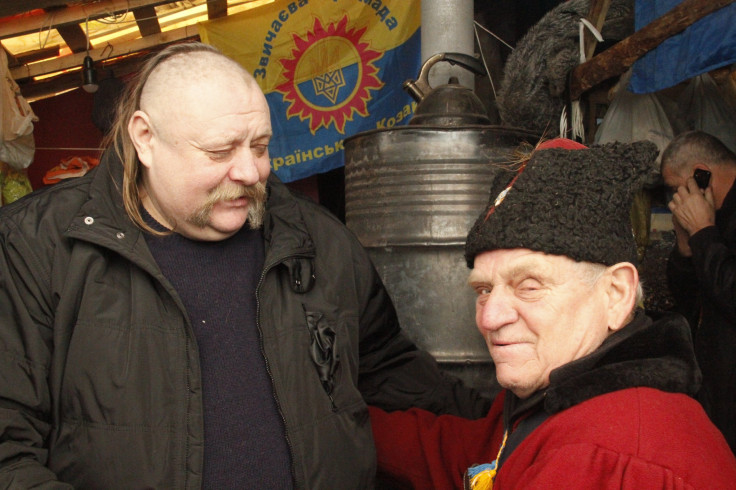
Not far from the Cossacks’ tent hangs a large black and white photo of Stepan Bandera, the leader of the Organization of Ukrainian Nationalists and its armed wing, the Ukrainian Insurgent Army, framed in the red and black colors of the Ukrainian nationalist flag. Bandera, considered a hero by many Ukrainians but a fascist by Crimea’s pro-Russians, led an organization that briefly allied itself with the Nazi German invaders of the Soviet Union and fought the Red Army well into the 1950s, an extraordinary feat under Stalin’s terror reign. His enshrinement here, like much that is on display in Maidan Square, is at once triumphal and disturbing.
It all is unknown and new, yet in its strangeness it has the familiarity of reminiscences from another time. Then you realize you have seen these sorts of displays before – in Roger Waters’ “The Wall” rock music show and its obvious precursors, the totalitarian forces that drowned Europe and the world in blood in the Second World War, a conflict that was born out of the entrails of this very geography in Mitteleuropa. As Alan Huffman pointed out in an International Business Times photo-essay, our eyes are already trained to see and decode all the elements in the Ukrainian uprising: The Maidan evokes the Bastille of Revolutionary Paris, with Libed – the woman in Kiev’s legendary founders monument, now that she’s holding the Ukrainian flag, uncannily resembling the heroic figure in Eugene Delacroix’s iconic painting “Liberty Leading the People.”
But the evocations don’t stop at 18th and 19th century France. The mobile kitchens and furnaces the Maidan rebels use bring the scene forward to the 1930s and 1940s, their wheels reminiscent of the cannons of World War II. There are stickers of the Russian flag with the swastika in the middle and a legend that reads, “The colors of the occupier,” as well as caricatures of Russian President Vladimir Putin with a short Hitler moustache. Then, to your left, it is revolutionary Russia, 1917, with Cossacks whose stylized moustaches bring to mind Austro-Hungarian Emperor Franz Joseph. It is all a bit unsettling, and disorienting, this mishmash of historical evocations: Hitler meets Stalin against the backdrop of the French Revolution, in a video game.
Standing before the charred office building that was burned in the worst days of fighting in the Maidan, a group of belligerent young men in the black clothes of the nationalists threaten another who is dressed in civilian clothes, accusing him of being an infiltrator. The black-shirted men form a circle around the accused and a man who looks like a videogame warrior glares at him.

Seeing the confrontation, an Orthodox priest, a short man with a wildly grown beard, intercedes and blesses everyone, making the sign of the cross. After a few minutes, the men disperse.
Soon another column approaches the Maidan’s podium to the cries of “Heroes don’t die!” The column of men carries the coffin of a 70-year-old Maidaner who had died the night before of a heart attack. A funeral ceremony is carried out by Orthodox priests from the podium as an elderly man in Cossack hat presides over the guard of honor beside the coffin. The men of the honor guard, and a few women, hold small, slender beeswax candles. Then the priests conclude their rites to the echo cry of “Heroes don’t die!,” a slogan the guard of honor repeats as they lift up the coffin and carry it to a white van waiting by one of the entrances of the Maidan barricades. In the liturgical calendar, it is the Sunday of expulsion, when God banned Adam from Eden.
Night falls. The fires flicker in the Maidan.
On the overnight train from Kiev to Simferopol, the Crimean capital, Anya, a 22-year-old student wearing a Mickey Mouse T-shirt, says she fears the worst. “I don’t see anything good coming up,” she says, turning her eyes toward the pitch-dark night beyond the windows, as the train clatters across the Ukrainian countryside.
As the express train speeds past the first Crimean stations the following morning, small clusters of three or four men in military fatigues and red armbands stare from empty platforms. In Simferopol’s Lenin Square, there is a sea of Russian flags, as well as a few red ones bearing the hammer and sickle, some of the Russian Black Sea Fleet and many of Crimea. A formation of men in uniforms that identify them as Kuban Cossacks guards a local government building.
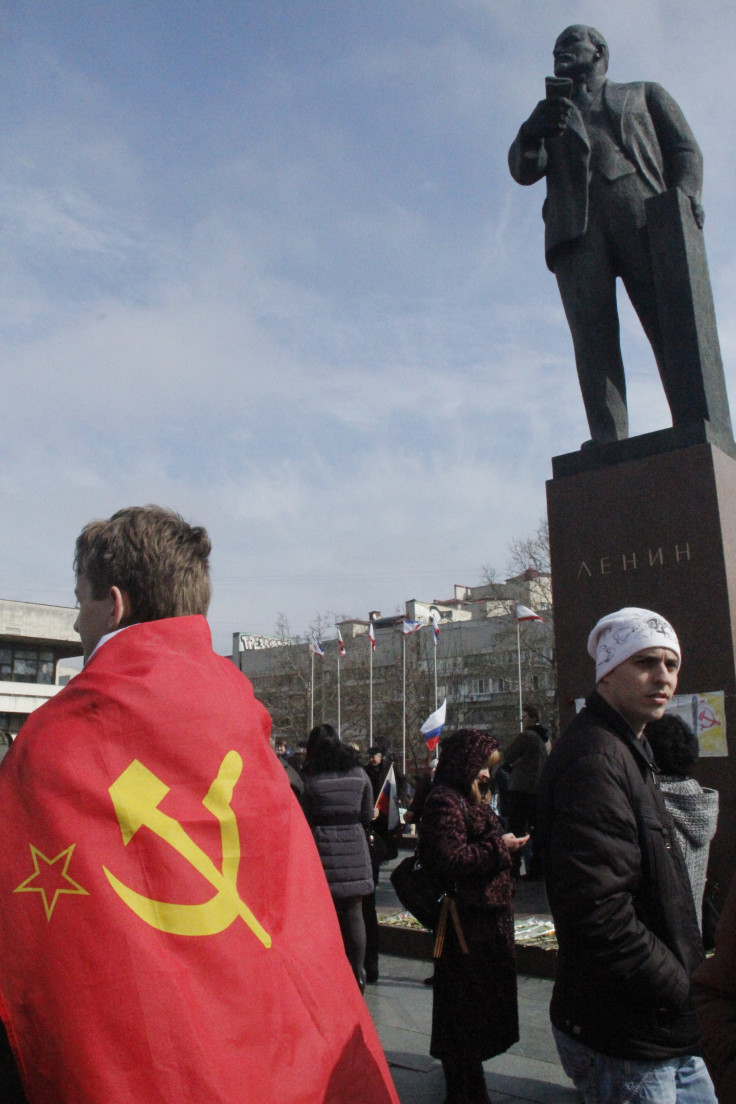
Speaker after speaker denounces the Ukrainian government from a podium built on the square, calling them fascists. People repeatedly shout, “Crimea is Russian!” A woman who gives her name as Liva, who is 30 and moved to Simferopol from Sochi, Russia, 13 years ago, is all for Russia. “We are all Russians; life under Ukraine is unbearable, the economy is a disaster,” she says.
Liva’s husband, Dinis, 31, a doctor, pitches in to say that all this conflict is “being cooked up by Jews on both sides.” Liva laughs and looks away, a bit embarrassed. “They are doing this to make money out of it,” he says. No, he is no anti-Semite, he says. “The fascists are those in Kiev,” he says, unflustered by a contradiction he doesn’t see.
Next to them, Vadim Uralov flies a big Soviet flag. He is not a Communist, he says. It’s just that life under the Soviet Union was better. How about freedom? Liva intervenes to say that freedom is “a relative notion: It means something different for everyone.” Uralov adds, “We were a strong country” – he means the Soviet Union – “it was just the West who didn’t want us to be powerful.” Crimea will join Russia, he says, and then the Ukrainians can go to Europe. “That’s not for the Russians,” he says. Why? “Europe is a museum,” he says, bringing up laughs from those surrounding him. “Our place is with Russia, that’s where our culture is.”
Standing on the ledge surrounding Lenin’s statue, Andrei Starodubtsev, 27, a Russian surgeon born in Tashkent, Uzbekistan, observes the rally from behind his dark aviator sunglasses. His family moved to Simferopol when he was 6. “Half the people are keeping silent,” he observes in a low voice, when the cries of “Rossiya!” (“Russia!”) go up at the cue of the speakers.
The crowd now falls into silent rapture as opera singer Angela Zakharova takes the podium for a rendering of the Polovtsian Dances from Borodin’s “Prince Igor.” The flags at Lenin Square move in waves in the cold afternoon wind, as Zakharova’s soprano voice agitates the crowd. “Улетай на крыльях ветра…” – “Fly on the wings of the wind…” – she sings. The opera was based on “The Tale of Igor’s Campaign,” an epic that glorifies a defeat that Russian prince Igor Svyatoslavich suffered against the Polovtsian, a Turkic tribe, in territory that is now part of Ukraine. She sings a piece in which the Polovtsians glorify their Khan, unequalled in his brightness by the sun, though in her rendering she omits those chorus lines.
All this bodes ill for everyone, Andrei says as he coldly contemplates the spectacle. He takes off his sunglasses and takes in the crowd and the flags, and says it’s all leading toward an international war. A world war? He smiles, sadly. “Well, no, that may happen too…” he begins, then says he means it will lead to ethnic conflict. “Ukrainians, Russians, Tatars, they will kill each other.” He adds, “I don’t like Putin, but what were these people in Kiev thinking that was going to happen?” Then he jumps off the ledge. “Time to go,” he says.
Two policemen in Ukrainian uniforms ensure order as a march of pro-Russian demonstrators joins the group in the square. As the column walks by a bus stop to the cries of “Russia! Russia!”, one woman – who up to that moment appeared unmoved by the larger demonstration on the square just across the street – joins their patriotic chorus with great fervor as a Tatar-looking woman standing next to her on the bus stops looks at her in surprised contempt.
Most Tatars, the original inhabitants of the peninsula until they were deported by Stalin during World War II (and returned decades later only to become a minority in their own land), are against unification with Russia. “Tatars fear a second deportation under the Russia of Putin,” says Mustafa Dzhemilov, who takes part in a much smaller Ukrainian-Tatar demonstration, in which a few dozen people have gathered outside the headquarters of the Tatar channel ATR, waving Ukrainian flags and protesting against the Russians.
So it goes in Simferopol. Later, on the bus to Sevastopol, Kyril Ivanov, a 22-year-old math student, says he doesn’t feel Russian although ethnically he is one. “I feel a Slav,” he says. He hopes there will be no war, but his fears grow by the day. He puts on the earbuds connected to his mobile phone and soon dozes off. When the bus stops at a checkpoint marked with Russian flags, a tall young man in an unmarked uniform comes up and, ignoring every other passenger, walks straight to the math student in the last row of seats, asks him to open his backpack and goes through its scant contents. Then, having found nothing of interest, he gets off the bus.

In Sevastopol, the base for the Russian Black Sea fleet and a bulwark of past Soviet glory with an abundance of immaculate hammers and sickles on public buildings, children dance to the rhythms of imaginary music as they play in a rotunda by the bay, while in the distance a formation of Russian ships guards the entrance to the port.
A few blocks from there, at the Pobeda bar, Sasha Lisovol, a 24-year-old Ukrainian manager from Kiev, and her boyfriend, Vadim Kravchenko, 25, a Sevastopol native of Ukrainian and Russian descent, discuss the situation. “Some of these people think they are still living in the Soviet Union,” Sasha says of the Crimean residents. Vadim, who considers himself Ukrainian, fears that the Russians will not stop at Crimea. “If the European Union and the United States don’t help us, Ukraine will be divided… The Russians will first take Crimea, then Odessa, then the Eastern Ukraine,” he says. “Putin will keep sending in Cossacks and Russian forces, like a disease.” In response, he says, "Tatars will be unhappy, and they will fight."
"And I think Ukrainians will join the Tatars in the fight against the Russians," Sasha adds.
The Pobeda bar, whose name in Russian means “Victory,” is dedicated to all things Soviet, from Zhiguli cars to the Izvestia newspaper and pictures of Soviet fleet sailors. There are two big parrots in a cage. Asked whether the birds speak Russian or Ukrainian, a restaurant waitress says, “They don’t speak anything, but if they spoke Ukrainian…” She half-smiles cynically and indicates with her hands that she would twist the parrots’ neck.
Back in Kiev, Iryna, a volunteer at the Ukraine Crisis Media Center, says that all of this makes her want to take a vacation. She brings up the possibility of Zakynthos Island, in Greece, but she knows how improbable it all is in this situation. She finds images of the blue water surrounding the island endlessly fascinating. It’s the color of her eyes, someone suggests to her. “No, my eyes are gray,” she says, then corrects herself. “They actually change colors, when I’m in a good mood, but on days like these they are gray,” she says as she waves her hands at the view from the Ukrayna Hotel atop a hill overlooking the Maidan, with its gilded statue of Archangel Michael, the patron saint of Kiev, and the blues and yellows of the banners and flags, the flames of a bonfire or two amid the tents, all of it surrounded by piles of flower bunches to the Ukrainian revolution martyrs, under the pale sky of a sunless afternoon in a city whose buildings and women challenge the notion that beauty is in the eye of the beholder.
The sense of doom hangs over the city, bringing to mind the destruction of life and beauty during the last world war -- cities that looked like Kiev and people who looked like these, who are now willing or unwilling actors in a process larger than themselves. The destruction of civilization seems unspeakable, here on the cusp of war.
On a Ukrainian International Airlines flight out of Kiev, the flight attendant pushes the cart of duty-free items. Prominent among them is an elaborate white box of perfume, like a miniature temple, with the words “La Vie Est Belle" inscribed across the top.
La vie est belle. Life is beautiful.

© Copyright IBTimes 2025. All rights reserved.





















